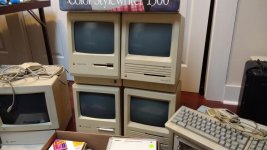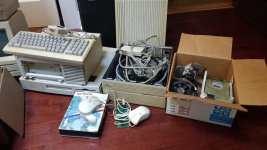zombienerd
Veteran Member
I'm meeting up with an older gentlemen tomorrow afternoon to check out his collection of older Mac's. He didn't know the models, but said they were the "old box style all in one type" machines from the 80's / early 90's. I'm guessing it's the original Mac / Plus / 128 types, but there may be newer ones.
He runs the computer department at the local charity thrift store, and holds zero interest or knowledge of the value and/or collectability of older machines. He straight up told me he just throws away anything that comes into the shop that is more than 6 years old. My jaw dropped and told him to keep anything pre-2000, and I'd at least give them $5 for any machine that old, so it's more money to their church.
He mentioned that he had several old macs in his storage shed, and while I'm not a big Mac guy, he said he was just going to scrap them eventually, so I figured I'd take a look and offer a few bucks for them.
What should I look for? What models were more collectible? If he'll take 5-10 bucks each, I'll probably grab all of them. Worst case scenario (if none of them work), I can part them out to you guys. I'm hoping there might be a few gems that are salvageable, I'd love to play with an old mac or two.
He runs the computer department at the local charity thrift store, and holds zero interest or knowledge of the value and/or collectability of older machines. He straight up told me he just throws away anything that comes into the shop that is more than 6 years old. My jaw dropped and told him to keep anything pre-2000, and I'd at least give them $5 for any machine that old, so it's more money to their church.
He mentioned that he had several old macs in his storage shed, and while I'm not a big Mac guy, he said he was just going to scrap them eventually, so I figured I'd take a look and offer a few bucks for them.
What should I look for? What models were more collectible? If he'll take 5-10 bucks each, I'll probably grab all of them. Worst case scenario (if none of them work), I can part them out to you guys. I'm hoping there might be a few gems that are salvageable, I'd love to play with an old mac or two.




